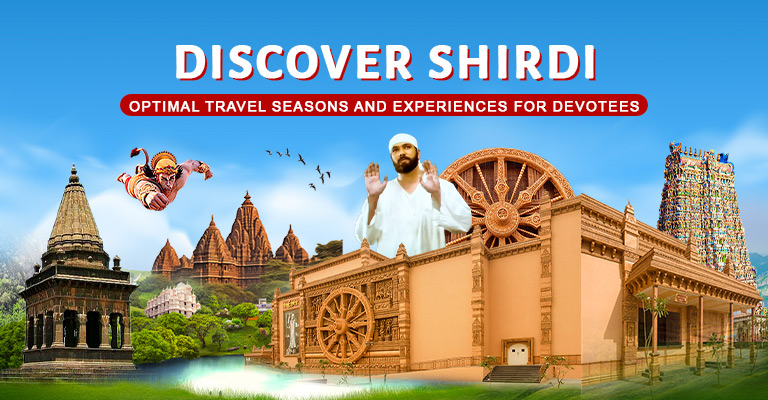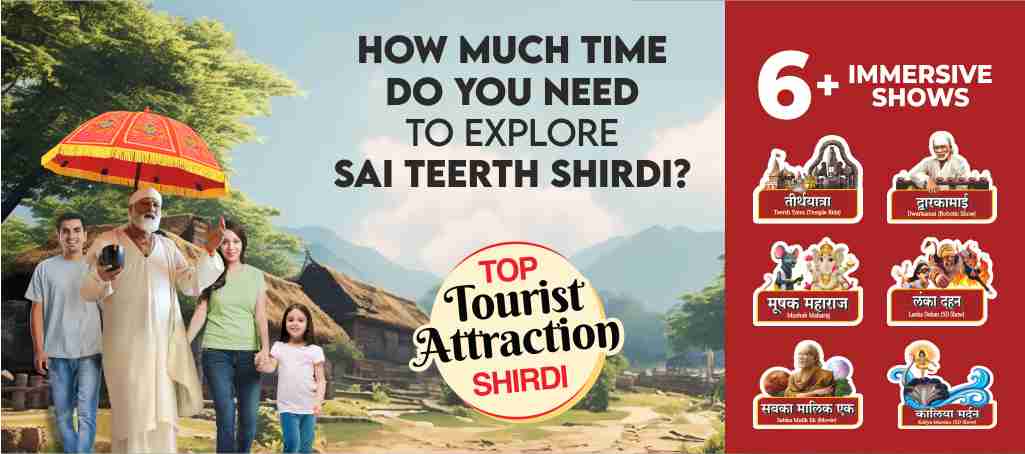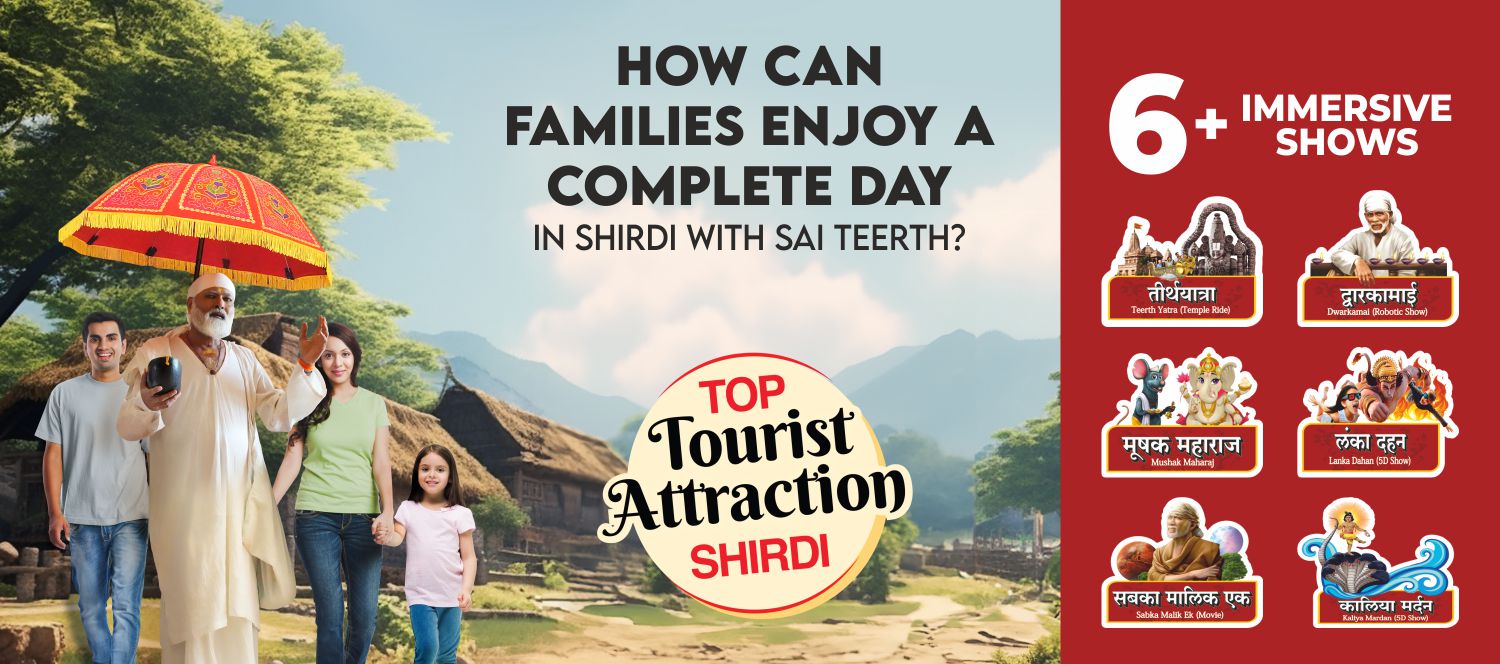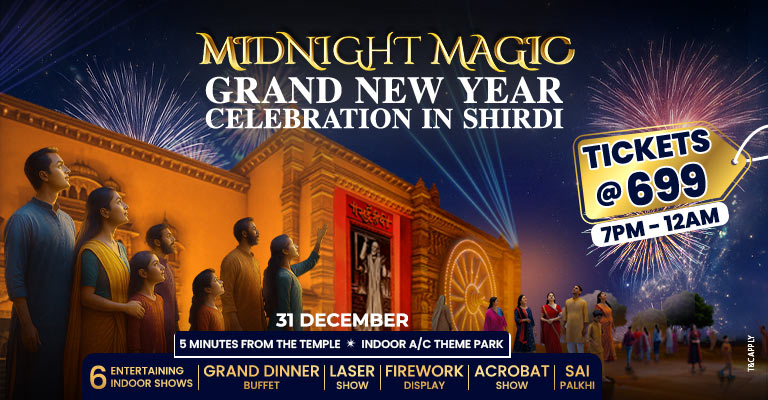When Is the Best Time to Visit Shirdi?
- Shirdi is a major pilgrimage town in Maharashtra.
- It is the holy place of Shri Sai Baba Temple.
- Devotees visit all through the year.
- But some months are more comfortable and less crowded than others.
What Is the Peak Season in Shirdi? (October to February / March)
- Months: October, November, December, January, February, sometimes early March.
- Weather:
- Pleasant and cool.
- Ideal for standing in darshan queues.
- Festivals in this period:
- Diwali
- Dussehra / Vijayadashami
- Guru Purnima (sometimes)
- Gudi Padwa
- New Year and long weekends
- Crowd level:
- Shirdi is usually more crowded.
- Expect long lines at Sai Baba Temple and hotels to be busy.
- Who should choose this time:
- Families who travel during school holidays.
- Devotees who want to enjoy festival aartis and celebrations.
- First-time visitors who want the full Shirdi experience.
How Is the Shoulder Season in Shirdi? (April to June)
- Months: April, May, June.
- Weather:
- Hot summer.
- Temperature can go up to 40°C.
- Afternoons are sunny and tiring.
- Crowd level:
- Less crowded compared to winter.
- Shorter waiting time for darshan.
- Travel tips for summer:
- Prefer early morning or evening darshan.
- Carry a cap, water bottle, and light cotton clothes.
- Choose a hotel with air-conditioning.
- Who should choose this time:
- Devotees who want Shirdi less crowded.
- People comfortable with heat and wanting quiet temple time.
What About the Monsoon and Off-Season? (July to August)
- Months: July and August.
- Weather:
- Monsoon rains from light to heavy.
- Temperature around 23°C to 33°C.
- Roads can be wet and slippery.
- Crowd level:
- Generally low to moderate.
- Good for those who like a peaceful atmosphere.
- Pros:
- Green surroundings.
- Cooler than summer.
- Cons:
- Outdoor sightseeing can be disturbed by rain.
- Carry umbrellas, raincoats, and extra footwear.
How Is Shirdi in September and Early Summer?
- September:
- Rains start reducing.
- Weather becomes pleasant again.
- Good option to avoid peak crowds.
- Late March and early April:
- Transition from winter to summer.
- Manageable if you prefer moderate crowd and warm climate.
What Is the Best Time of Day to Visit Shirdi Sai Baba Temple?
- The temple is open from early morning to late night.
- Different aartis and pujas happen at fixed times.
Main Temple Programmes (Approx. Timings & Charges):
- Kakad Aarti
- Time: 5:15 AM
- Early morning aarti at Samadhi.
- Charge: ₹600 per person
- Mangalsnaan of Shri Sai Baba
- Time: 5:50 AM
- Ritual bath of idol.
- Usually not separately charged.
- Darshan Starts
- Time: 6:25 AM
- Paid darshan: ₹200 per person
- Shri Sai Satyavrata Puja
- Timings: 7:00 AM, 9:00 AM, 11:00 AM
- Charge: ₹100
- Abhishek Puja
- Timings: 7:00 AM, 9:00 AM
- Charge: ₹100
- Madhyanh Aarti (Noon Aarti)
- Time: 12:00 Noon
- Charge: ₹400
- Dhup Aarti (Evening Aarti)
- Time: At sunset
- Charge: ₹400
- Shej Aarti (Night Aarti)
- Time: 10:00 PM
- Charge: ₹400
Charges may change. Check the official Shri Saibaba Sansthan website.
How to Choose the Best Temple Visit Time for Less Crowd?
- For less rush:
- Try weekdays instead of weekends.
- Prefer early morning after Kakad Aarti.
- Late night Shej Aarti feels calm (may be crowded on special days).
- During festivals like Guru Purnima, Ram Navami, Dussehra, Diwali → heavy crowd.
What Else Can You Do in Shirdi Besides Temple Darshan?
- Gurusthan
- Place where Sai Baba first appeared.
- Peaceful spot for prayer.
- Dwarkamai
- Masjid where Sai Baba spent many years.
- Contains dhuni and grinding stone.
- Shani Shingnapur (nearby)
- Famous temple of Lord Shani.
- Half-day or full-day trip.
- Local markets
- Shops selling photos, idols, prasad, and souvenirs.
What Makes Sai Teerth Theme Park Special?
- Located minutes from Sai Baba Temple.
- India’s first devotional theme park.
Main Highlights:
- Laser Show
- Visual storytelling of Sai Baba’s life.
- Good for children and adults.
- “Sabka Malik Ek” Giant Screen Film
- A film on Sai Baba’s journey.
- Dwarkamai Experience
- Recreated with robotics.
- Sai Palki & Rubik Cube Mosaic
- Mosaic made from thousands of Rubik’s cubes.
- Lanka Dahan 5D Show
- 5D show of Hanuman’s Lanka adventure.
- Teerth Yatra Ride
- Ride through models of ten sacred temples.
Facilities at Sai Teerth Theme Park:
- First-aid and medical help.
- Baby feeding rooms and clean washrooms.
- Locker and baggage areas.
- Parking space.
- Food court with vegetarian options.
How Can You Plan Your Shirdi Trip Smoothly?
- Decide the best time based on:
- Your weather preference.
- Crowd tolerance.
- Festivals you want to attend.
- Check Shirdi weather forecast and pack accordingly.
- Book travel and hotel early for peak season.
- Keep one day extra for darshan and sightseeing.
Frequently Asked Question
The ideal time is from October to February/March.
Yes, you can visit from April to June, but be prepared for high temperatures up to 40°C and humidity.
July to August is the monsoon season, with temperatures between 23°C and 33°C.
Here are some key rituals:
Kakad Aarti: 5:15 AM – ₹600 per person
Mangalsnaan (Holy Bath): 5:50 AM – Free
Darshan Starts: 6:25 AM – ₹200 per person
Shri Sai Satyavrata Puja: 7:00 AM, 9:00 AM, 11:00 AM – ₹100 per person/couple
Abhishek Puja: 7:00 AM, 9:00 AM – ₹100 per person/couple
Madhyanh Aarti: 12:00 PM – ₹400 per person
Dhup Aarti: Evening – ₹400 per person










